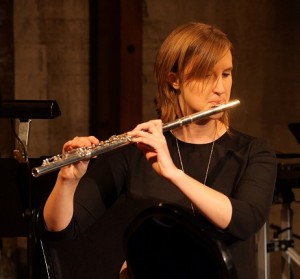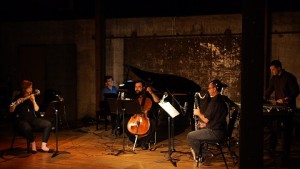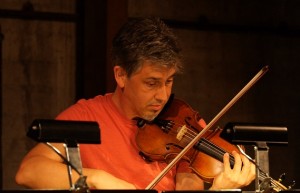WasteLAnd Concert in Los Angeles – Study for Eurydice
 On October 30, 2015 WasteLAnd presented Study for Eurydice, a concert at Art Share LA in downtown Los Angeles. A nice Friday night crowd filled the restored industrial performance space for an evening of new music.
On October 30, 2015 WasteLAnd presented Study for Eurydice, a concert at Art Share LA in downtown Los Angeles. A nice Friday night crowd filled the restored industrial performance space for an evening of new music.
The first piece, Relay/Replay by Yiheng Yvonne Wu, featured Rachel Beetz on flute. A computer played recorded flute sounds through speakers mounted above the performance area. Relay/Replay began with a brief high-pitched tone from one of the speakers, answered in kind by the flute. A short silence followed and the sequence repeated. A pattern of call and answer continued and the electronic part gradually changed as the replies by the became more varied as if a conversation were occurring in a different language. A low trill from the flute was mimicked by similar sounds from the speaker, like birds calling back and forth. Towards the end of the piece there were sounds from both speakers that ultimately resolved into a low, pure tone. This was actually a recording of the flute – greatly slowed down – that added a mysterious feel. The flute passages that followed felt more organic and brighter by contrast. The low tone increased in volume, becoming dominant and more assertive as the piece ended. Relay/Replay is an intriguing combination of flute playing and electronic sounds derived from the flute, artfully uncovering both similarities and differences.
Susurrus by Panayiotis Kokoras for violin, cello and piano followed, beginning with a series of sharp rapping sounds from the players on their respective instruments. The result was a sort of unsettled clatter that was soon joined by the amplified strumming of strings inside the piano. There was an active and tense feel to all of this – there were no musical tones heard initially, but rather the rhythmic rattle of various extended percussive techniques. Eventually a sustained cello note was heard that slowly decreased in pitch and some piano strings were plucked to form identifiable notes. At one point the musicians voiced the sounds of rushing air using their breath and this added a remote, windswept feeling to the proceedings. Apart from a few notes heard now and then, there was no conventional melody, beat or regular rhythm and this gave an edgy, feral feel to the ensemble. The coordination between the players here was remarkable given how far this piece stands outside the bounds of conventional music. Susurrus is a journey that takes the listener past the limits of ordinary musical practice and into to new levels of expression.
Study for Eurydice, by Erik Ulman was next, performed by Mark Menzies on the violin. The opening passage was gently played and soft, ending with a quiet, questioning tone. This set the stage for the work and the gentle bowing by Menzies produced a continuous, low murmur of irregular phrases as the piece progressed. The dynamics never rose above a whisper and yet the tones seemed to decrease in volume even further as this unfolded. Menzies was able to deliver some impressively quiet passages without any loss of intonation or continuity, greatly focusing the concentration of the audience. More significantly, these very soft sounds were not simply a quieter version of normal violin playing but rather they assumed a unique character – we were hearing something completely new. At the end the sound diminished still further, becoming airy and insubstantial – like watching smoke rise and disperse into nothingness. Study for Eurydice takes us to that place where extremely quiet dynamics drastically alter our perception and hearing of the sound. A remarkable performance by Mark Menzies.
After an intermission the premiere of Sections 1-20 by Michelle Lou was heard and this consisted of electric guitar and amplified cello along with a wide array of foot pedals, buttons and pick-ups connected to each instrument. The adaptation to electronic processing was amazingly complete and the sounds rendered were wonderfully distant from the familiar. The opening notes by the guitar were a rapid series of quacks and clucks. This resulted from some sort of feedback or process effect – the movement of the fingers and hand on the strings was very slight. There was no regular rhythm or beat, but the sound seemed like unfold like conversation amongst a crowd and the words flew by in clusters of very fast notes. The guitar became a human interface for the electronics rather than for the playing of tones by hands and fingers on the strings. As the piece progressed the pitches got lower and the feeling became more industrial, as if a mechanical process was close by. The entrance of the cello added to this by creating a light tone that sounded like one of the higher harmonics of a rotating bearing. The guitar now added a low rumble, distant thunder in a mechanized landscape. This rumble morphed into a sustained roar as the cello emitted a series of high, ray-gun like bursts that gradually lowered in pitch creating the feel of combat or battle as the piece ended. Sections 1-20 takes the audience to new territory – the acoustic instrument as human electronic interface – and produces a completely new listening experience.
 The concert concluded with Purple Quartz, by Timothy Harenda featuring bass flute, bass clarinet, cello, piano and vibraphone. This also included electronic processing and irregular passages and the players all were equipped with headsets or ear buds that provided a beat for coordination. Purple Quartz began with a flash of rapid notes with a pure, a bell-like quality from the domination of the vibraphone. The piece then proceeded in a series of fast, spiky passages that felt like being inside a box full of glass shards and metal fragments that was being shaken. The complex texture and surges of sound made for a vivid listening experience. Occasional piano notes were heard but this piece remained tense and anxious primarily because of the percussion and jagged nature of the phrasing. The tightness of the ensemble was impressive given the absence of any guiding beat. Purple Quartz is a strikingly expressive piece that is the product of imaginative writing and excellent playing.
The concert concluded with Purple Quartz, by Timothy Harenda featuring bass flute, bass clarinet, cello, piano and vibraphone. This also included electronic processing and irregular passages and the players all were equipped with headsets or ear buds that provided a beat for coordination. Purple Quartz began with a flash of rapid notes with a pure, a bell-like quality from the domination of the vibraphone. The piece then proceeded in a series of fast, spiky passages that felt like being inside a box full of glass shards and metal fragments that was being shaken. The complex texture and surges of sound made for a vivid listening experience. Occasional piano notes were heard but this piece remained tense and anxious primarily because of the percussion and jagged nature of the phrasing. The tightness of the ensemble was impressive given the absence of any guiding beat. Purple Quartz is a strikingly expressive piece that is the product of imaginative writing and excellent playing.
The partnership of electronics and acoustic instruments continues forward and the pieces performed in this concert explored new modes of expression that combined excellence in performance and innovation in composition.
The performers for Study for Eurydice were:
Rachael Beetz, flute, bass flute
Mark Menzies, violin
Derek Stein, cello
Richard Valitutto, piano
Nicholas Deyoe, electric guitar
Brian Walsh, bass clarinet
Justin DeHart, vibraphone
Photos courtesy of Micki Davis, Copilot Arts Documentation (used with permission)
